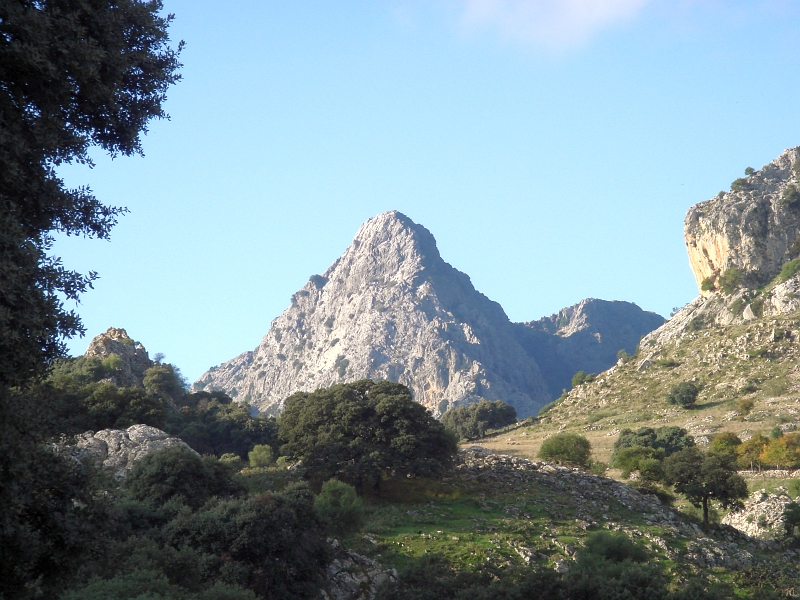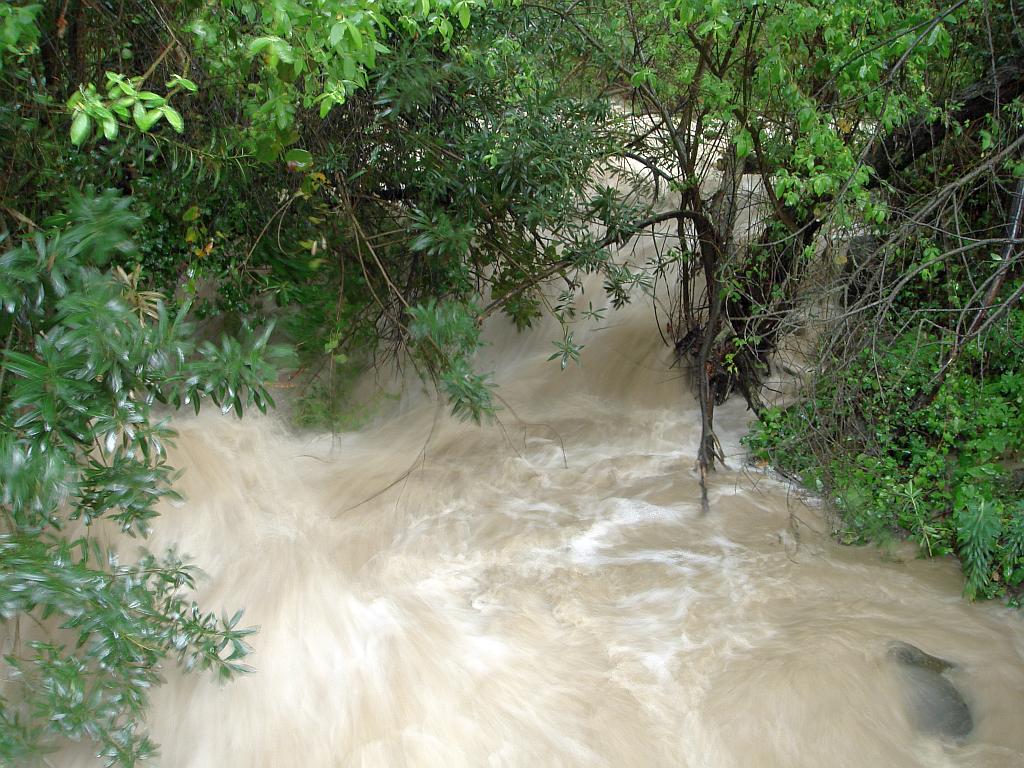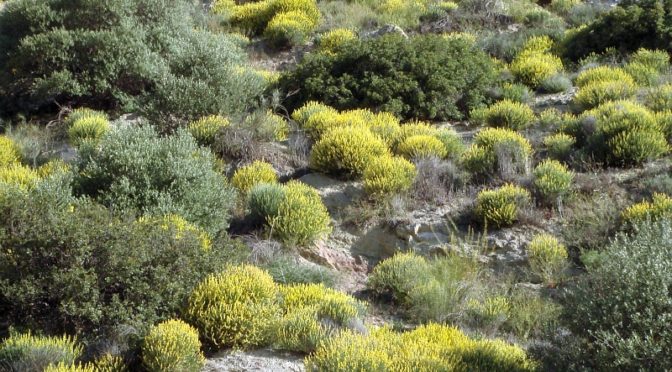The Sierra de Grazalema Natural Park protected area consists of a large cluster of high limestone peaks. Within the mountain ranges there are ecosystems with sheer and colourful cliff faces, deep lush valleys, rich green forests and bleak white scree slopes.
Read about Grazalema village here.
There are around 20 peaks above 1000m above sea level creating an impressively sculpted landscape. The highest is “El Torreón” at 1654m (5426 feet) which commands fabulous views across the mountains and as far as the plains of Cádiz province.
The area is captivating as so much of it is accessible and can easily be explored with new wonders on every turn. There are many footpaths where you can view the diverse habitats such as – a shaded riverside, a high exposed mountain peak or vertical cliffs that are home to nesting raptors.
Although most of the footpaths are freely open to the public there are four which enter into more sensitive areas that have their access restricted to limited numbers. (Click here to read about how to obtain these permits) There is also a small section in the heart of the park (Garganta Seca) that is completely closed to the public.
Natural Park status
For an area to be declared a Natural Park it must have something of interest to be protected. In this case primary importance is given to a type of fir tree that has spanned millions of years and now resides in a cluster of 3 parklands in south west Andalucía. This is the Abies pinsapo, Spanish Fir, which has managed to survive since the tertiary period through our planets evolutionary changes. Although the Grazalema Natural Park holds a large acreage of this relict species, other woodlands also exist within the nearby Sierra de las Nieves and the Sierra Bermeja.

Along with these rare fir trees a number of other flora and fauna are highlighted such as a large colony of resident Griffon Vultures (Gyps fulvus), a few resident/breeding pairs of the endangered Bonelli’s Eagles (Hieraaetus fasciatus) and herds of Spanish Ibex (Capra hispanica pyrenaica). There are also several flowering plants that are specialist to these mountains such as the Grazalema Poppy (Papaver rupifragum), Phlomis x margaritae, Erodium recoderi and Echinospartum algibicum.
A collection of images from the Malaga side of the Grazalema natural park
Many botanist tours select these mountains to feature on their spring itinerary as the variety of wildflowers are unique. Not only is the colourful combination beautiful but many individuals are either limited to: just this tiny area, to south western Andalucia or some are shared with northern Africa where the climate and terrain are similar. Around 1,400 species have been recorded here.
The park itself covers 51,695 hectares and is situated in the north east corner of Cádiz province and spills into the north west of Málaga province. The parklands northern border is the Zahara and El Gastor reservoir which through the summer is a remarkable shade of blue. The other boundaries are marked by villages; to the east Montejaque, west El Bosque and the southern tip extends a little way beyond Cortez de la Frontera.









Find a hotel in the Sierra de Grazalema
There are many natural springs within the area with four main rivers leaving it. The Rio Guadalete begins above the village of Grazalema and enters into the Zahara / El Gastor reservoir, thereafter meandering on to the Atlantic.
The Majaceite river is the southern-most trout river in Europe, and springs from the mountains behind Benamahoma. (This is joined by the Tavizna). The last is the Guadiaro, which begins near the town of Ronda and flows through a deeply cut and rich valley which forms much of the eastern park border and eventually connects with the Mediterranean sea at Sotogrande on the western Andalusian coast. The river flows fluctuate greatly through the changing seasons and in summer many small tributaries dry up completely.
The rain in Spain?
Grazalema village has been known through history as receiving the most rainfall in Spain. This comes about as it is the first high point for the cold air pushing in from the Atlantic ocean. It falls in deluges and it can run like a river through the streets, quickly draining away. There is a small dam above the village to contain some of this rainfall when it runs off the mountainsides as the village also suffers from drought through the summer months.
This makes springtime very lush and varied as the plants spurt into growth to complete their flower to seed cycle before the heat turns up in June, July and August.

The combination of high seasonal rainfall and mainly limestone rock creates an amazing landscape and also numerous caves and underwater systems. The Hundidero to Cueva del Gato cave system runs for 4 kilometres underground from sink hole (Sima) to its river exit. Both of which can be visited. (Entrance underground is strictly for experienced and well equipped teams due to the natural dangers within).
Historically the geological formations have been utilised, with cave paintings from Neolithic and Palaeolithic inhabitants that can be visited within another cave, known as Cueva La Pileta. (Guided tours in English / Spanish)
Olives and cork in the Sierra de Grazalema Natural Park
Agriculture within the park is mainly pastoral and arboreal with some annual crops. In many areas the land is steep and strewn with rocks but this does not deter the Olive grower. The fruit is knocked from the branches with long sticks each winter, falling onto nets laid out on the ground.
Cork is collected from the large woodlands by trimming it from the tree by axe, packing it onto mules, which then deliver it onto trailers for transportation. Read about cork here: https://wildsideholidays.co.uk/cork-and-its-huge-importance-to-the-environment/

Other traditional crafts that still provide local income include cheese making, apiculture (honey and pollen), flour milling, baking bread in wood fuelled brick ovens, weaving esparto into baskets and mats (a local mountain grass), woollen mill and textile weaving, olive oil pressing, Chorizo (spicy dried sausage) and Jamón (leg of pork) curing, leather work and wooden furniture creation.
The White villages or Pueblos Blancos
The winding mountain roads within the park boundaries linking the 10 “white villages” lead you through spectacular scenery. The highest road point is at “Puerto de las Palomas” or Doves Pass at 1357m (4452 feet) this offers amazing views over mountains, lakes and lowlands and is situated near to the northern park border. This pass road joins the lakeside “pueblo blanco” Zahara de la Sierra (which is topped by a Moorish tower) to the well known village of Grazalema in the heart of the parkland.

Inside the park the stacked, terraced and haphazardly shaped village houses have strictly retained the traditional colours of white walls, red clay roof tiles, black metal security bars and brown doors in order to maintain their charm.
Grazalema village, backed by impressive solid peaks of rock, may receive the lions share of visitors but each village in the area is worthy of a visit and relaxed walk through the white washed streets.
Ronda Today
Everything you need to know before you visit Ronda “The city of dreams” in Andalucia. https://www.rondatoday.com/
Visit Cádiz
Planning on visiting Cádiz? Tourist information. Monuments. Hotels. Activities. City guides: https://visitingcadiz.com/
The Caminito del Rey
Find tickets for the Caminito del Rey: https://www.caminodelrey.es/
Wildside Holidays – Spain
Take a trip on the Wildside! Discover the wildlife and nature of Spain, its Natural and National Parks and find the top wildlife, activity and walking holiday companies.
Iberia Nature Forum
Struggling with identifying those bugs and beasties? Why not check out the Iberia nature Forum! https://iberianatureforum.com/

11 thoughts on “The Sierra de Grazalema Natural Park”